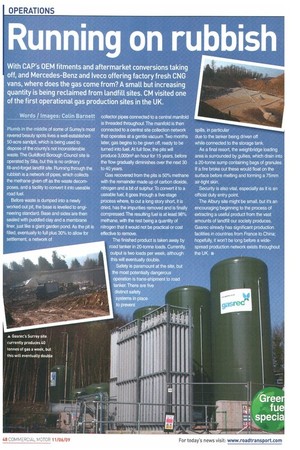Running on rubbish
Page 48

If you've noticed an error in this article please click here to report it so we can fix it.
With CAP's OEM fitments and aftermarket conversions taking off, and Mercedes-Benz and lveco offering factory fresh CNG vans, where does the gas come from? A small but increasing quantity is being reclaimed from landfill sites. CM visited one of the first operational gas production sites in the UK.
Words / Images: Colin Barnett
Plumb in the middle of some of Surrey's most revered beauty spots lives a well-established 50-acre sandpit, which is being used to dispose of the county's not inconsiderable waste. The Guildford Borough Council site is operated by Sita, but this is no ordinary fill-and-forget landfill site. Running through the rubbish is a network of pipes, which collects the methane given off as the waste decomposes, and a facility to convert it into useable road fuel.
Before waste is dumped into a newly worked out pit, the base is levelled to engineering standard. Base and sides are then sealed with puddled clay and a membrane liner, just like a giant garden pond. As the pit is filled, eventually to full plus 30% to allow for settlement, a network of
collector pipes connected to a central manifold is threaded throughout. The manifold is then connected to a central site collection network that operates at a gentle vacuum Two months later, gas begins to be given off, ready to be turned into fuel. At full flow, the pits will produce 3,000m3 an hour for 15 years, before the flow gradually diminishes over the next 30 to 40 years.
Gas recovered from the pits is 50% methane with the remainder made up of carbon dioxide, nitrogen and a bit of sulphur. To convert it to a useable fuel, it goes through a five-stage process where, to cut a long story short, it is dried, has the impurities removed and is finally compressed. The resulting fuel is at least 98% methane, with the rest being a quantity of nitrogen that it would not be practical or cost effective to remove.
The finished product is taken away by road tanker in 20-tonne loads. Currently, output is two loads per week, although this will eventually double.
Safety is paramount at the site, but the most potentially dangerous operation is trans-shipment to road tanker. There are five distinct safety systems in place to prevent spills, in particular due to the tanker being driven off white connected to the storage tank.
As a final resort, the weighbridge loading area is surrounded by gullies, which drain into a 20-tonne sump containing bags of granules If a fire broke out these would float on the surface before melting and forming a 75mm air-tight skin.
Security is also vital, especially as it is an official duty entry point.
The Albury site might be small, but it's an encouraging beginning to the process of extracting a useful product from the vast amounts of landfill our society produces. Gasrec already has significant production facilities in countries from France to China; hopefully, it won't be long before a widespread production network exists throughout the UK. di
















































































































































